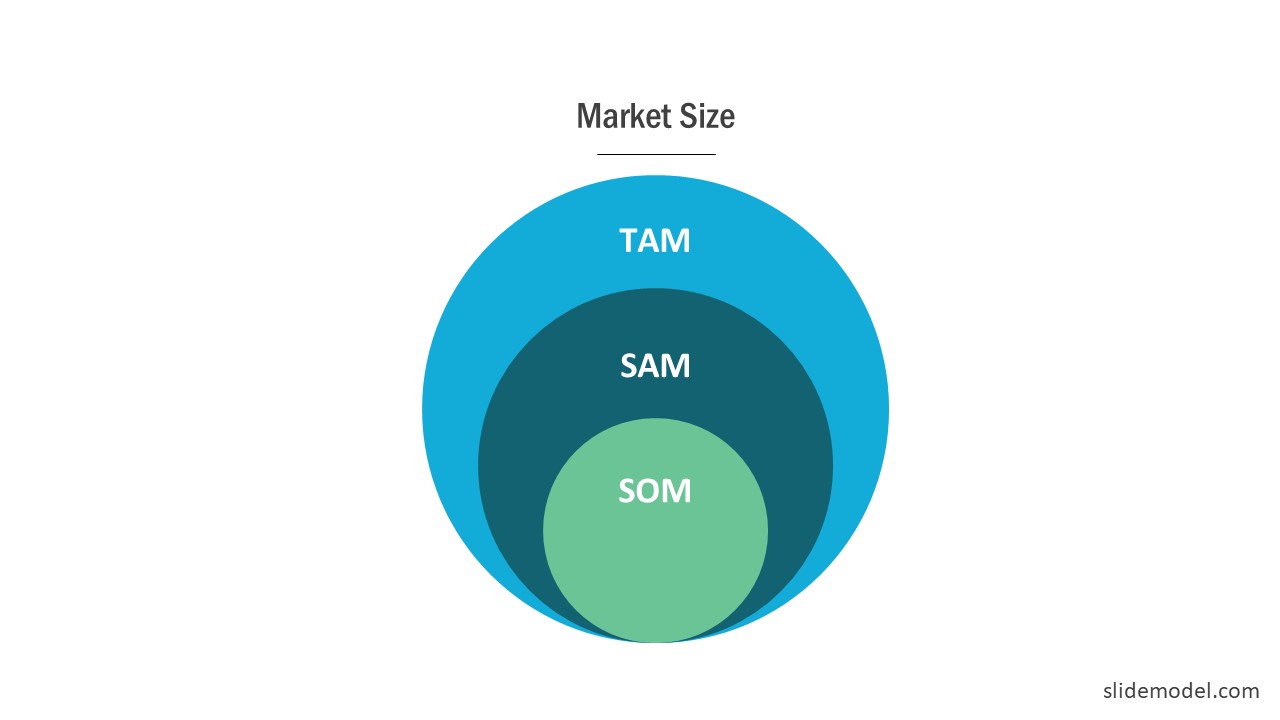TAM SAM SOM : What Do They Mean & How Do You Calculate Them?
In marketing and business, the concept of market potential is crucial to survival and even more so prosperity. In this regard, TAM SAM SOM concepts come to the fore. These three words describe various levels of your market, assisting in estimating the extent of the business opportunity, the focus markets, and the market entry options.
In this article, we will define what TAM, SAM, and SOM are, explain their relevancy, and present efficient calculation practices for investors.
What Are TAM, SAM, and SOM?
To decide whether or not to introduce a new product, position it for the new market, or risk investing, such companies often compute these three measures:
- TAM (Total Addressable Market): This is how much revenue a certain market has when only a product gets 100% of shares in order to provide this specific product/service. It is the biggest pool of potential revenue your product could ever capture.
- SAM (Serviceable Available Market): SAM is a greater sensible subset of TAM, representing the portion of the total marketplace that your commercial enterprise’s service or product can realistically reach, given modern-day capabilities and barriers.
- SOM (Serviceable Obtainable Market): SOM is the portion of SAM that your business can realistically capture inside the brief to medium time period. It considers factors like competition, finances, assets, and market positioning.
Each of these metrics offers insight into a unique element of marketplace capacity, helping corporations plan and strategize with a clear understanding of their boom opportunities.

Why Are TAM SAM SOM Important?
TAM, SAM, and SOM are important for both startups and set up groups for a number of reasons:
Investor Decisions: Investors take a look at TAM, SAM, and SOM to assess the capability of a company. A large TAM can suggest better long-time period potential, even as a realistic SOM reflects conceivable near-term revenue.
Market Entry Strategy: These metrics assist in identifying which phase of the marketplace to goal first and the way to scale over time.
Product Development: Understanding TAM, SAM, and SOM can manual a enterprise’s service or product roadmap by indicating where call for lies and which capabilities will attract the biggest customer base.
Calculating TAM, SAM, and SOM can assist your enterprise create a roadmap that considers each ability sales and attainable dreams.
How to Calculate TAM
Calculating TAM can be achieved in several approaches, depending in your industry and the statistics to be had. Here are some of the common techniques:
1. Top-Down Approach
The top-down technique includes searching at industry reviews, statistics from marketplace research corporations, or authorities information. This data affords an estimate of the entire length of the market, which you may then alter based totally on specific elements relevant on your enterprise.
Example: If a report states that the global market for health apps is valued at $10 billion, and your commercial enterprise specializes in yoga apps, you can estimate that TAM is 20% of that price or $2 billion. However, this method lacks precision, because it regularly is predicated on large market figures.
2. Bottom-Up Approach
The backside-up method is regularly greater correct than the top-down method. It includes calculating TAM based totally in your own services or products pricing, then multiplying it by using the overall quantity of capability clients.
Example: If your yoga app subscription costs $50 in keeping with year and you estimate that there are 40 million people worldwide interested in yoga apps, your TAM would be 40 million * $50 = $2 billion.
3. Value Theory Approach
The value theory approach considers how much value your product provides to customers and what they are willing to pay. This method is particularly useful for innovative products that lack direct market comparisons.
Example: If you estimate that your fitness app could help users save $500 annually in gym fees, you might set your pricing accordingly to capture a share of this perceived value. You then multiply this by the estimated number of potential users.
How to Calculate SAM
Calculating SAM focuses on the portion of TAM that is relevant to your specific business’s capacity and target market. SAM considers geographic, demographic, and logistical constraints that limit your ability to capture the entire TAM.
Example of Calculating SAM Using Market Segmentation
If your yoga app is currently only available in the United States, and your TAM was calculated globally, you’d need to adjust SAM to reflect only the U.S. market.
- Suppose there are 10 million potential users for yoga apps in the U.S., and your subscription remains $50 per year. In this case, your SAM would be 10 million * $50 = $500 million.
Market segmentation data, demographic research, and surveys can all help refine your SAM calculation.
How to Calculate SOM
SOM is the most realistic and achievable portion of the market that your business can capture in the near term. SOM factors in the competitive landscape, market share analysis, budget, and other real-world conditions that affect your ability to gain customers.
Example of Calculating SOM
Assuming that your yoga app competes with ten comparable apps inside the U.S. And your resources will let you seize simplest 10% of the SAM, your SOM would be calculated as:
- SAM ($500 million) * 10% = $50 million.
This $50 million represents the immediate revenue potential for your business. Understanding SOM helps in setting realistic goals, planning marketing budgets, and aligning resources with achievable growth targets.
TAM, SAM, and SOM in Business Strategy
TAM, SAM, and SOM calculations are not just theoretical metrics. They play an active role in shaping various business strategies, such as:
- Market Penetration Plans: By understanding SOM, businesses can focus on strategies to capture their immediate market share.
- Scaling and Expansion: As an organization grows, it could look to extend its SAM with the aid of concentrating on new geographic regions, client segments, or introducing new merchandise.
- Product Development Priorities: TAM facilitates assessing ability demand for product upgrades, expansions, or new offerings.
When combined, TAM, SAM, and SOM offer a basis for sound strategic making plans, useful resource allocation, and realistic purpose-putting.
Challenges in Calculating TAM, SAM, and SOM
While these metrics are valuable, they also include challenges:
Data Availability: Accurate market records may be hard to find, especially in rising industries or niche markets.
Market Dynamics: Customer choices, financial situations, and competitor movements can adjust marketplace length and the relevance of TAM, SAM, and SOM.
Evolving Goals: As a agency grows or pivots, its TAM, SAM, and SOM can also shift, requiring periodic recalculation and realignment with new business goals.
Conclusion
TAM, SAM, and SOM are critical metrics for any enterprise looking to apprehend its market capability, set conceivable dreams, and allocate resources efficiently. While TAM represents the overall revenue ability of a marketplace, SAM narrows it right down to a sensible goal phase, and SOM gives a realistic view of what may be performed in the short time period. By frequently analyzing these metrics, businesses can refine their strategies, reply to marketplace changes, and make knowledgeable selections that align with both immediate goals and long-term boom aspirations.
Frequently Asked Questions (FAQs)
1. What is the distinction between TAM, SAM, and SOM?
TAM (Total Addressable Market) is the whole market capacity if you may seize a hundred of the marketplace. SAM (Serviceable Available Market) is the part of TAM that is realistically handy using your enterprise, considering vicinity and other constraints. SOM (Serviceable Obtainable Market) is the portion of SAM that your business can capture in the short term, taking opposition and useful resource barriers into consideration.
2. Why are TAM, SAM, and SOM vital for startups?
TAM, SAM, and SOM assist startups in apprehending their marketplace potential, setting practical sales dreams, attracting investors, and planning growth techniques. Investors, particularly, have a look at these metrics to gauge the lengthy-term ability and on-the-spot viability of a commercial enterprise.
3. How regularly should I recalculate TAM, SAM, and SOM?
Businesses should recalibrate TAM, SAM, and SOM periodically, especially while getting into new markets, introducing new merchandise, or facing adjustments inside the aggressive panorama. Regular recalculations make sure that strategies remain aligned with present-day marketplace dynamics and company desires.




